Not So Different from Us
This post responds to a prompt where I will write as if I am describing what I've seen in the Netherlands to a family member who is likely to reply that the Netherlands is far different from the United States and that what works here would not work in the U.S.
Fun fact: did you know the Dutch also complain when anyone talks about taking a parking spot away? It's true! During the tour of the Dutch city Nijmegen, our guide, Sjors, mentioned that in creating much of the bicycling network we witnessed and biked along, pushback over parking existed and presented a barrier to the city council in supporting projects that would increase the bicycling infrastructure around the area. In describing one presentation about increasing bicycling infrastructure he gave to government officials, Sjors mentioned spending the first 10 to 15 minutes talking exclusively about cars. This aspect impressed upon me how many Dutch think about their cars and ease of driving, which is not so different compared to the U.S. But, what I also took away from the comment from Sjors is how even conceptualizing solutions to support more biking transportation requires accounting for the car. But the hidden benefit in what he said, was highlighting how more biking can mean fewer cars on the road and alleviating traffic congestion, something I imagine most U.S. drivers would be very interested in seeing manifest.
Next, I might anticipate a rebuttal from my audience (and I had this discussion with a close friend in Boston two days before arriving) that goes along the lines of, "Well, if you increase the amount of biking then all these bikes will be in the way of my car!" Here is where the detractors do have a stronger argument. In the Netherlands, there is a clear culture of trusting other people, conveyed through the awareness of eye contact between pedestrians, bicyclists, and drivers. I would like to say that this is possible in the U.S., but that is not the case right now. However, how the Dutch reached that point comes from a historical fact that launched some initial momentum for greater cycling and more restrictive rules on car travel and that is safety. I have mentioned before that the leading cause of death among children in the U.S. is car crashes. Therefore, reducing both the number of trips by cars and more important as we are learning, the speed at which they travel, can be two starting points for which to argue in favor of increasing biking transportation.
 |
| A local street with two lanes of bicycle traffic and a two-directional, car lane in the center; car parking remains and is permitted on the edge of the sidewalk, maximizing the space utilized |
A good example of the transformation that can occur by reducing car speeds and promoting bicycle transportation came today at the end of a city tour of Utrecht. Our guide Ronald showed the group a picture of the street we arrived on in the recent past. It appeared as many streets in the U.S. do today, with multiple car lanes and mostly paved roads. The street had transformed with a redesign to introduce objects that calmed traffic, slowing car speeds and supporting bicycle transportation. The street was visibly lively in the condition we observed, with people walking, biking, and driving. Shops lined the sides of the road, and there was clearly an active commercial element with groups dining outside along the sidewalks and shopping at the local grocery store. There are countless examples of streets in the U.S. with this potential for transformation. So, the lesson to convey to my audience would be, "They had such roads as we have and chose to redesign them another way. We could just choose as well and possibly get a better place from it."
 |
| A redesigned street providing spaces for biking, driving, and walking in a vibrant neighborhood outside of the Utrecht city center |
Perhaps the most interesting detail provided in the example is that when Ronald and his colleague proposed an incremental change of the street to the shop owners along this street, they were met not by resistance but disappointment. To quote Ronald, they were challenged by the shop owners who asked, "Can't you do better than this?" I do not believe that is a solely Dutch cultural characteristic; that's a human characteristic that resembles people's desires for, well, nice places. Trees and green spaces providing shade. Parks and ponds. Choices among several small businesses dotting a street that invites people to walk, bike, and even drive pursuing their choices to purchase goods and services, or to dine out.
I find it hard to believe that wanting a safer street to walk on, safer for children to cross a road from school to a grocery store, and a more pleasant place to shop and dine is a uniquely Dutch cultural characteristic. I hear my relatives compliment many spaces in European countries they visited on vacation, especially open plazas and green spaces. So, I would emphasize and point out to them, "Those spaces weren't always that way. They too had wide, asphalt-paved streets with half-empty parking lots once before and decided to reimagine them as public places. And today, people still drive cars, but more people now walk bike and walk, and they are safer spaces." We can choose to reimagine and redesign our roads to create public spaces such as this as well. I am willing to bet that it would probably be good economics for our local communities as well, and who wouldn't support that in the U.S.?



Comments
Post a Comment